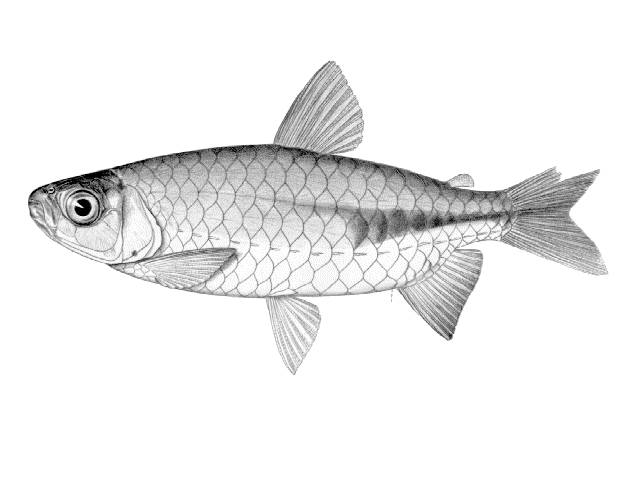| Alestidae (African tetras) |
| 16.55 cm SL (male/unsexed) |
|
pelagic; freshwater |
| Africa: Sanaga River in Cameroon to the Chiloango River in Angola (Ref. 28013, 80290). Also widely distributed in the Congo River basin (Ref. 11970, 28013, 42019, 80290). |
|
Dorsal soft rays (total): 10-10; Anal spines: 0-0; Anal soft rays: 14-16. Diagnosis: fronto-parietal fontanel absent in adults, sometimes pore-like in juveniles; snout short, more than 3x head lenght; dorsal fin origin at same level as, or just behind, pelvic fin insertion; sexual dimorphism affecting anal fin shape; head length/snout length 3.1-3.7; 24-30 lateral line scales; 4.5 scales between lateral line and dorsal fin; 9.5-11 predorsal scales; 11-13 anal fin branched rays; 16-21 gill rakers on lower limb of first gill arch; 8 teeth in outer premaxillary row; adults medium-sized; humeral spot always present; broad black band on flanks; most apparent part of this band not reaching or extending beyond vertical through posterior base of dorsal fin (Ref. 80290).
Description: fronto-parietal fontanel present in very small individuals, disappearing with growth; gill rakers rather thin and short; 8 outer premaxillary teeth aligned in a single row; anal fin with 3 branched and 11-13 unbranched rays (Ref. 80290). Adult males with marked sexual dimorphism of anal fin, more rounded than in females where fin is more concave distally (Ref. 28013).
Coloration: prominent humeral spot on third post-opercular scale; distinct longitudinal band from middle of rayed dorsal fin to adipose fin (situated dorsal to median rays of caudal fin); band is wider anteriorly than posteriorly, anteriorly it is about 1 scale wide; in preserved material fins generally greyish; in life Ref. 41597 writes: “fins sometimes yellow, sometimes orange; adipose fin sometimes bright red” (Ref. 80290). |
| Affinities: close to B. taeniurus and B. opisthotaenia; body with clearly wider band than the former; dark band starts less forward than in B. opisthotaenia, originating slightly posterior to vertical through dorsal fin origin in B. kingsleyae, but originating at a vertical through dorsal fin origin in B. opisthotaenia (Ref. 80290). |
|
Least Concern (LC); Date assessed: 16 February 2009 Ref. (130435)
|
| harmless |
Source and more info: www.fishbase.org. For personal, classroom, and other internal use only. Not for publication.

